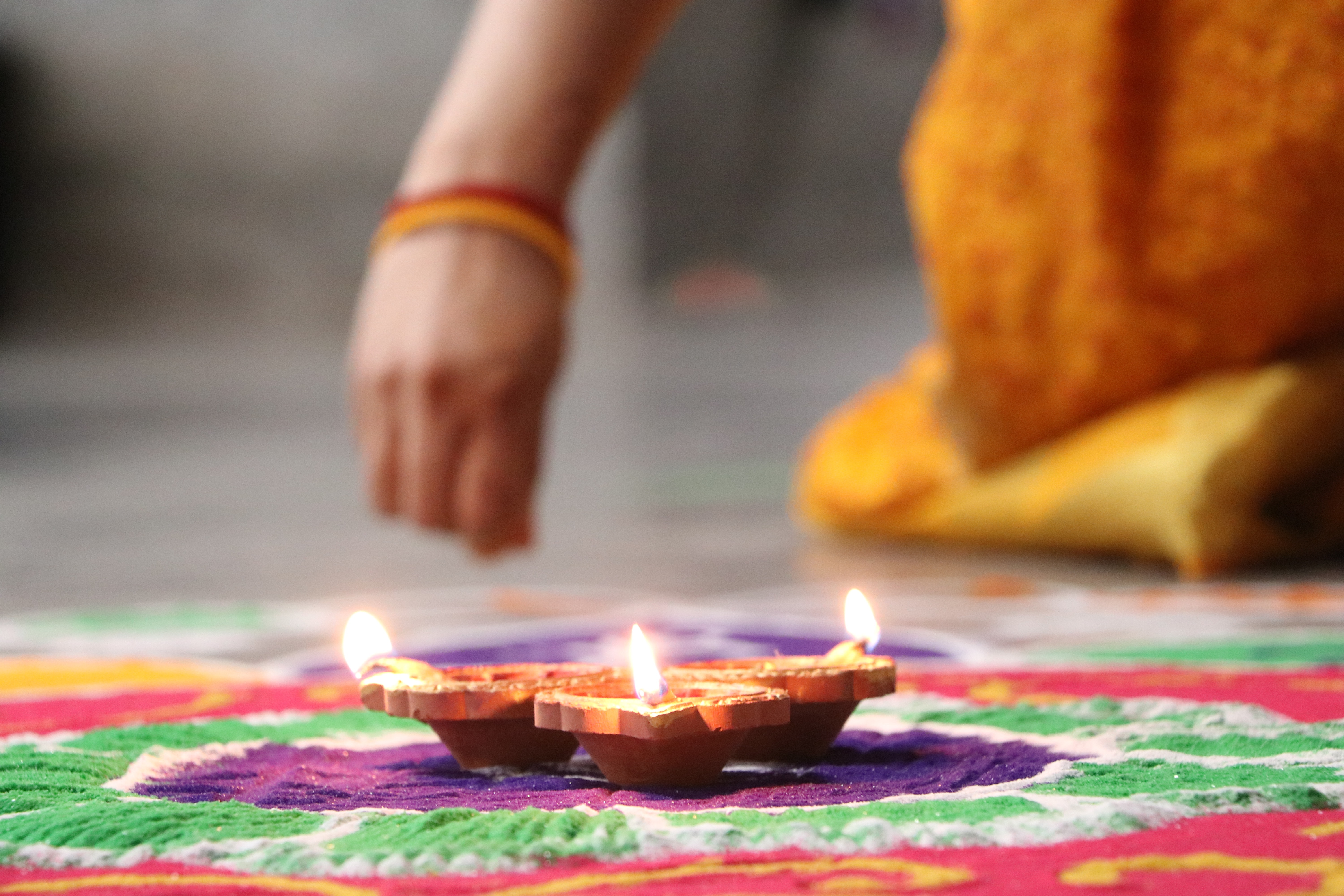Resources
Children dressed as Lord Krishna wait for a fancy dress competition. Credit: Ajay Verma/Reuters
Black, Brian. The Character of the Self in Ancient India: Kings, Priests, and Women in the Early Upaniṣads, New York: SUNY Press, 2007.
Bonazzoli, Giorgio. “The Dynamic Canon of the Purāṇas.” Purana 21, no. 2 (July 1979): 116–66.
Brereton, Joel."The Composition of the Maitreyī Dialogue in the Bṛhadāraṇyaka Upaniṣad." Journal of the American Oriental Society 126, no. 3 (2006): 323–345.
———. “The Upanishads.” In Approaches to the Asian Classics, edited by William Theodore de Bary and Irene Bloom, 115–135. New York: Columbia University, 1990.
Bryant, Edwin F., translator. Krishna: The Beautiful Legend of God (Srimad Bhagavata Purana Book X). New York: Penguin Classics, 2004.
Cayanus, J. L. “Using Teacher Self-Disclosure as an Instructional Tool.” Communication Teacher 18, no. 1 (2004), 6–9.
Chamberlain, Daniel F., and J. Edward Chamberlin, eds. Or Words to That Effect: Orality and the Writing of Literary History. UK ed. edition. Philadelphia: John Benjamins Publishing Company, 2016.
Chinmaya Mission. 2007–2011. Bala Vihar Teachers’ Handbooks. Piercy, California: Chinmaya Mission Trust.
Clifford, James, and George E. Marcus, eds. Writing Culture: the Poetics and Politics of Ethnography. Berkeley: University of California Press, 1986.
Davis, Richard H. The Bhagavad Gita: A Biography. Princeton: Princeton University Press, 2014.
Dempsey, Corinne G. The Goddess Lives in Upstate New York: Breaking Convention and Making Home at a North American Hindu Temple. Oxford: Oxford University Press, 2006.
Eco, Umberto. Six Walks in the Fictional Woods. Cambridge, MA: Harvard University Press, 1998.
Gillespie, Marie. Television, Ethnicity and Cultural Change. London: Routledge, 1995.
Grinshpon, Yohanan. Crisis and Knowledge: The Upanishadic Experience and Storytelling, New Delhi: Oxford University Press, 2003.
Gu, Xiaoqing, Bian Wu, and Xiaojuan Xu. “Design, Development, and Learning in e-Textbooks: What We Learned and Where We Are Going.” Journal of Computers in Education 2, no. 1 (March 1, 2015): 25–41.
Jamison, Stephanie and Michael Witzel. "Vedic Hinduism." In The Study of Hinduism, edited by Arvind Sharma, 65–113. Columbia, SC: University of South Carolina Press, 2003.
Lindquist, Steven E. "Gender at Janaka's Court: Women in the Brhadāraṇyaka Reconsidered." Journal of Indian Philosophy 36, no. 3 (2008): 405–426.
———. "Lines of Descent and Dissent: Genealogy, Narrative and the Upaniṣads." Religions of South Asia 5, no. 1 (2011): 29–49.
———."Literary Lives and a Literal Death: Yājñavalkya, Śākalya, and an Upaniṣadic Death Sentence." Journal of the American Academy of Religion 77, no. 1 (2011): 33–57.
———. "Narrating the Upaniṣads." In Religion: Narrating Religion, edited by Sarah Iles Johnston, 303–316. MacMillan: 2016.
———. "Prominent Characters in the Upaniṣads." In The Upanishads: A Complete Guide, edited by Signe Cohen, 95–106. New York: Routledge, 2017.
———. "The Social Background: Caste and Gender in the Upaniṣads." In The Upanishads: A Complete Guide, edited by Signe Cohen, 81–92. New York: Routledge, 2017.
Lutgendorf, Philip. The Life of a Text: Performing the Rāmcaritmānas of Tulsidas. Berkeley: University of California Press, 1991.
Marcus, George, E. “Ethnography Two Decades after Writing Culture: From the Experimental to the Baroque.” Anthropological Quarterly 80, no. 4 (2007), 1127–1145.
Mokashi, D. B. Palkhi: An Indian Pilgrimage. Translated by Philip C. Engblom and Eleanor Zelliot. Albany, NY: SUNY Press, 1987.
Narayan, Kirin. Storytellers, Saints, and Scoundrels: Folk Narrative in Hindu Religious Teaching. Philadelphia: University of Pennsylvania Press, 1989.
Narayan, R. K. The Ramayana: A Shortened Modern Prose Version of the Indian Epic. New York: Penguin, 2006.
Oddie Geoffrey A. Popular Religion, Elites, and Reforms: Hook-swinging and its Prohibition in Colonial India, 1800–1894. New Delhi: Manohar Publishers & Distributors, 1995.
Olivelle, Patrick, editor and translator. The Early Upaniṣads: Annotated Text and Translation. New York: Oxford University Press, 1998.
Olivelle, Patrick, translator. Pañcatantra: The Book of India’s Folk Wisdom. New York: Oxford University Press, 2002.
Olivelle, Patrick. "Young Śvetaketu: A Literary Study of an Upaniṣadic Story." Journal of the American Oriental Society 119, no. 1 (1999): 46–70.
Palmer, Parker, J. The Courage to Teach: Exploring the Inner Landscape of a Teacher’s Life. San Francisco: Jossey-Bass, 2007.
Patwardhan, Anand. In The Name of God [Rām Ke Nām] Mumbai: Anand Patwardhan Productions, 1991.
Richman, Paula, ed. Many Ramayanas: The Diversity of a Narrative Tradition in South Asia. Berkeley: University of California Press, 1991.
Rodrigues, Hillary. Hinduism – the eBook. 2nd ed. Journal of Buddhist Ethics Online Books, 2016.
———. Introducing Hinduism. 2nd ed. London and New York: Routledge, 2016.
Rodrigues, Hillary, ed. Studying Hinduism in Practice. New York: Routledge, 2011.
Rolfe, Vivien E., and Douglas Gray. “Are Multimedia Resources Effective in Life Science Education? A Meta-Analysis.” Bioscience Education 18, no. 1 (December 1, 2011): 1–14.
Smith, John D., translator. The Mahabhārata. New York: Penguin, 2009.
Stelzer, Timothy, Gary Gladding, José P. Mestre, and David T. Brookes. “Comparing the Efficacy of Multimedia Modules with Traditional Textbooks for Learning Introductory Physics Content.” American Journal of Physics 77, no. 2 (January 12, 2009): 184–90.
Vanita, Ruth, ed. Queering India: Same-Sex Love and Eroticism in Indian Culture and Society. New York: Routledge, 2013.
———. Same-Sex Love in India. London: Penguin, 2008.
Zipes, Jack, translator. The Complete Fairy Tales of the Brothers Grimm. New York: Bantam Books, 1992.

